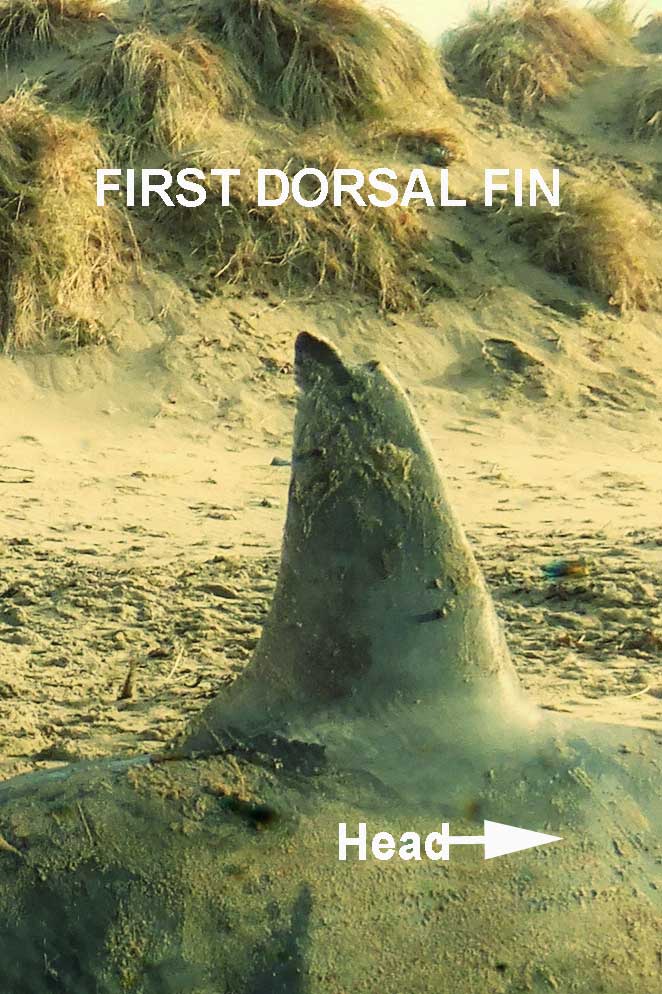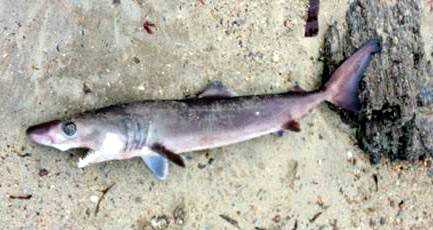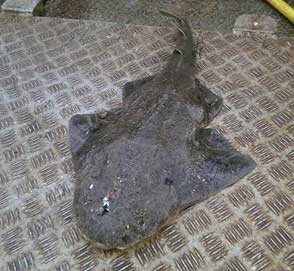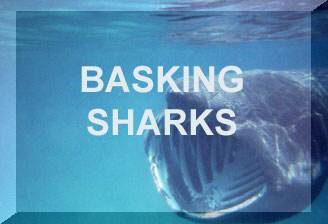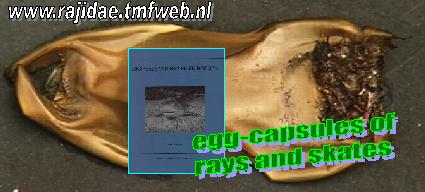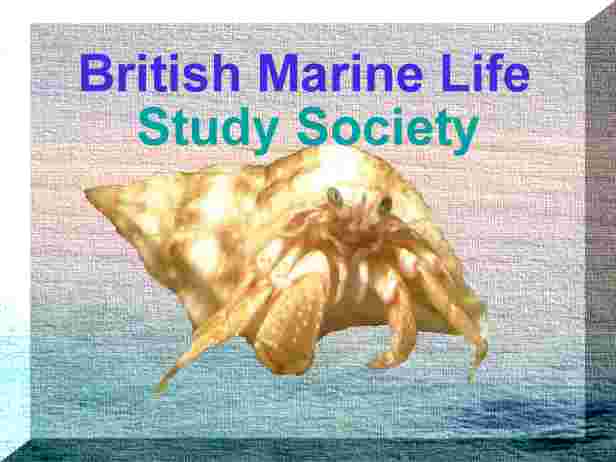 |
| Homepage |
| Index |
| News |
| Main Links |
 |
| Fish Page |
|
|
European
Elasmobranch Association (Shark Trust)
 |
| Forum |
| U.K.
ANGLER'S SHARKS,
SKATES AND RAYS http://www.sue-jeri.demon.co.uk/ |
| Sharks
for the younger reader |
|
|
At least 21 species of sharks have been recorded in British coastal waters. In addition at least 12 species of Skates and Rays, one species of Stingray and 2 species of Electric Rays also live in the shallow seas surrounding Britain. Other species occur in deeper water.
The commonest inshore shark species of the N E Atlantic is the Lesser Spotted Dogfish, Scyliorhinus canicula, which rarely grows much longer than 1 metre in length. The egg case of this small shark is known as a Mermaid's Purse.
No fatal shark attacks have
been recorded in British coastal waters. There has been one unsuccessful
attack on a SCUBA diver.
11
March 2008
6:00
pm (arrive from 5:00 pm) - 7:30 pm
Shark Biology
and Conservation
Scientific
Seminar,
Venue:
Zoological Society of London, Regent's Park, London
Free
admission for the talks
Booking
in advance only for the dinner
Contact:
Joy
Hayward
Zoological Society of London Scientific Meetings
European Elasmobranch Association
The European Elasmobranch Association, Shark Trust, National Marine Aquarium, Rope Walk, Coxside, Plymouth PL4 OLF, UK.European Elasmobranch Society (Shark Trust)
Shark Trust Annual Conference 2002To subscribe to SHARK-L, send a message to
LISTSERV@UTC.EDU and put the following in the
body of the message:
SUBSCRIBE SHARK-L Your Name
Archives: http://raven.utc.edu/archives/shark-l.html

MARINE WILDLIFE of the NE ATLANTIC OCEAN EFORUM PAGE (LINK TO) |
New Millennium Shark & Ray News
(NE Atlantic Ocean)
Click
on the image to find the web page with the
latest
Shark News
NEWS 2004
News: Thresher Shark land at Plymouth
September 2015
False
Catshark
Scottish
Tagging Programme Image
A deep water species of shark was caught in Scottish seas by scientist from Marine Scotland. The False Catshark sometimes known as a Sofa Shark, Psuedotrakias microdon, is the 72nd species of elasmobranch recorded from around Scotland. The 2 metre long 60 kg shark was caught close to the Isle of Barra in the Outer Hebrides. This bottom dwelling shark would be normally be expected to live at depths of 1000 metres or more.
Scottish Shark Tagging Programme facebook20
October 2013
A
deep water Greenland Shark,
Somniosus
microcephalus,
was found freshly dead stranded at Embleton
Bay in Northumberland. The three metres long female shark was recovered
by staff of Newcastle University
and held frozen at their Dove
Marine Laboratory at Cullercoats. The Cetacean
Strandings Investigation Programme (CSIP) retrieved the shark whilst
carrying out demonstration necropsies for undergraduates at Newcastle University
and transported it to the Natural
History Museum in London, who have (Autumn
2014) completed preparing the shark as a specimen
for the national collection. This
large species of shark (> 7 metres & 1,400 kg) is usually found at
depths of 1000 metres in the Arctic and boreal Atlantic and is both rarely
recorded around the British Isles and relatively little is known of it
biology and bionomics.
5
December 2014
A
two metres long Shortfin Mako Shark,
Isurus
oxyrinchus, was washed ashore dead on
the vast sandy shore at Barmouth,
Cardigan
Bay, west Wales.
 |
Barmouth
Shark
Photograph
by Harry
Allday
|
Identification of the the Mako and Porbeagle, Lamna nasus, is difficult and I determined it to be the rarer Mako from the shape of the first dorsal fin lacking a white patch. It is difficult because of the pointed snout and position of the secondary dorsal fin I first thought it was a Porbeagle. Teeth may indicate a Porbeagle? Porbeagle & Mako ID Barmouth
Shark Dorsal Fin
|
|
 |
The dismembered remains of a recently ingested Harbour Porpoise, Phocoena phocoena, were found within the stomach of the 2.67 metre female Mako Shark. Picture Credits: CSIP-MEM |
18
July 2013
A
large streamlined Shortfin
Mako Shark,
Isurus oxyrinchus,
was hooked by Andy Griffith
30 miles off Milford
Haven, SW Wales. This dangerous shark leapt three metres into the air
off the stern of the boat before Andy
with the help of his crew mates managed to land the two metres long shark
after a fight lasting 40 minutes. Great care was taken to ensure the safety
of angler and crew as large specimens of this shark have been identified
in fatal attacks on humans. The 90 kg shark
was landed and then released. This is the
first record off the Welsh coast.
(NB:
this fish is very similar to the more often encountered Porbeagle
Shark,
Lamna
nasus. The ID is usually confirmed
by the teeth.)
26
August 1999
Fishermen
(6 witnesses) from Cornwall report a large predatory shark off Padstow,
Cornwall, with a length reported of 3.6 metres (11 ft). If allowances
are made for exaggeration, it could be a Porbeagle Shark, Lamna
nasus, that attains a length of 3 metres, or a Shortfin Mako,
Isurus
oxyrinchus, which could reach a length of nearly 4 metres. The Mako
is a dangerous shark although attacks on humans are rare, virtually non-existent.
Occurrences of the warm water Mako in British seas are usually recorded
in August and are rare, although they are occasionally caught in commercial
nets.
Could it be a Great White Shark?
The
report appeared in the Sun newspaper when it was identified as the Great
White Shark,
Carcharodon carcharias,
which is unknown from British seas. This identification has not been
ruled out. If it is a Great White its occurrence in area where large numbers
of larger Basking Sharks have been seen may not be a coincidence. Great
Whites could prey on them. AH.
The temperature of the sea
off Cornwall is estimated to be about 18° C in August. Great Whites
occur regularly in the Mediterranean Sea where the winter sea temperatures
are likely to fall to 13° C (Naples) so that the usual reason of temperature
intolerance is not the most likely reason for its absence around the British
Isles in summer. My guess would be the availability of prey on a
regular basis whilst the sea temperature is warm enough is the reason for
its absence. If it is a Great White its occurrence could be associated
with the huge numbers of Basking Sharks in the
last 2 years. The same reasons could apply for the appearance of Mako Sharks.
Sea
Temperature Chart
The Cornish sea temperatures
will only exceed 13° C from June until October. Warm water fish and
sharks will have to return south to deeper seas or die.
The newspapers have shown
pictures of Basking Sharks, which are known to be prevalent this year.
Rolf Williams (National Aquarium, Plymouth) went up to Padstow on to the boat and spoke to some of the observers - he considers the shark was 11 foot plus, so it was either a very large Porbeagle (possibly a Mako ?) or a Great White Shark. He thinks it is a 50/50 chance. Cornwall has enough Grey Seals to provide a dinner table for all the Great White Sharks in the East Atlantic. We were sent film of a Great White Sharks seen off Minehead by Westcountry TV. It was lovely footage of a Basking Shark.
I have interviewed four of the crew who saw the 'Great White Shark'. Their identification is based only on size, colour, and estimated weight. None of the crucial distinguishing features were described and they did not express a knowledge of what to look for - most notably the white free rear tip on the first dorsal fin. I had a good look at the boat, a 28 footer, against which they judged size. The shark appeared 40 ft off and passed just 5 ft from the boat in a single glide at the surface. It was seen for about 45 seconds total. I believe that it is quite possible that the shark was a very large Porbeagle. The FAO species catalogue 1984 puts a possible maximum length for Porgies at 370 cm / 12 ft. The crew fish for Porbeagles regularly but have not previously caught any close to this record size. I believe that an error of 3 ft could have been made in judging length, and that all the other features they described to me equally describe a Porbeagle. Off course we will never know, but I think it is probable that there is a monster Porbeagle off Padstow because there is no doubt that they saw a colossal shark. Since they regularly target this species with gear that can land such a shark, we may yet see this fellow again...?!
Cheers,
Rolf
Williams
Interpretation
Officer. (National
Aquarium, Plymouth)
Record Weights (British seas):
Shark,
Mako Isurus oxyrinchus
Boat 500
lb
-00-00 Eddystone, Devon
J M Yallop 1971
Metric 227 kg
Shore 40-00-00 Vacant Qualifying weight
Shark,
Porbeagle Lamna nasus
Boat 507 lb -00-00 Dunnet Head, Scotland
C Bennett 1993
Metric 230 kg (World Record)
Shore 40-00-00 Vacant Qualifying weight
Sussex Porbeagle
1 February
1999
A three metres* long Mako
Shark, Isurus oxyrinchus, (the consensus
now seems that it is a Porbeagle) was caught three miles
off Brighton by cod fishermen and brought into Monteum Fish Market at nearby
Shoreham-by-Sea.
The shark weighed 172 kg (378
lb). The largest shark normally caught
in Sussex seas is the Tope,
Galeorhinus
galeus, and then only occasionally. Rarely Porbeagle Sharks,
Lamna
nasus, have even been caught, but this is my first report of a Mako.

[* One report said 2.2 metres, excluding the tail fin?]
Shark Page
Letter to Shoreham Herald
PS: On further examination the shark looks like a Porbeagle. AH 11/2/99.
Further investigation underway.
The
consensus now seems that it is a Porbeagle.
Doug
Herdson, Marcus Goodsir, Andy Horton. 16/2/99.
I
have now seen the colour photograph and this clearly indicates a Porbeagle.
AH.
5
Porbeagles landed at the fish market in Plymouth from September 1998 to
February 1999, the largest being a female of 243 cm (115 kg). Doug
Herdson.
Porbeagle landed in Guernsey on 10 March 1999. Sarah Fowler, Shark Trust.
The local fishermen know that large sharks live off the north-east of England, especially around Coquet Island, near Amble off the Northumberland coast. They are caught every year, but in 1998, more sharks and larger specimens were caught. Both the Porbeagle Shark, Lamna nasus, and the Shortfin Mako Shark, Isurus oxyrinchus, were reported. Unfortunately these two sharks are often confused. On 13/14 August two Shortfin Mako Sharks (one about 5 metres long and the other larger) were caught in salmon nets about 3 miles south-east of Whitby, North Yorkshire. One of the sharks had 3 Lampreys Petromyzon marinus embedded in it. We have also received a September report of two Porbeagle Sharks estimated to weigh 190 kg (420 lb) and another larger one with an estimated weight of 363 kg (800 lb), as well as large sharks off the Tyne and one landed at Hartlepool. We have not been able to check the precise dates of these records, although the Mako reports came from the National Marine Aquarium, Plymouth, Rare Fish Records, kept by Doug Herdson.
Great White Mako
http://www3.nrk.no/distrikt/vestfold/nyheter/711080.html
9 November
2015
A
two metre long Porbeagle Shark,
Lamna
nasus, washed up dead on Cullen
Bay, north-east Scotland.
A two metre long Porbeagle Shark, Lamna nasus, was the unfortunate victim of a net and was washed ashore dead on Chesil Beach. The body of the shark was returned to sea, as commercial fishermen in the EU are prohibited from landing Porbeagle Sharks. 24 August 2012
A Porbeagle Shark, Lamna nasus, is discovered dead on the sand of Filey Beach, Yorkshire.
23
May 2012
An
exceptionally large Porbeagle
Shark,
Lamna nasus, was caught
on road and line by Wayne Comben and Graeme
Pullen and released 300 metres off Boscastle,
north Cornwall. It was measured at about 10 ft (3 metres) long with a girth
of about 2 ft (60 cm) which experts think was likely to be a pregnant female
with an estimated weight of 550 lb (250 kg) and this would have
exceeded the previously largest shark caught by an angler in British seas
beating the previous 1993
world angling record for the species of
230 kg. The shark towed the small boat for a mile before it was hauled
alongside. Even if it was possible to land the fish on to the boat, the
Porbeagle is now a protected species under European
Union (European Commission
on Fisheries) legislation.
7
November 2011
The
European Union (European
Commission on Fisheries) officially extended measures to protect
threatened Porbeagle Sharks, Lamna
nasus, from fishing. Under the amended Regulation, fishing for
porbeagles is now prohibited in all EU waters, including the Mediterranean
Sea, and by EU vessels fishing in international waters. In addition, if
porbeagles are caught accidentally, they must now be released immediately.
28
July 2011
A
female
Porbeagle Shark,
Lamna
nasus, with a reported weight of nearly 300
lb
(136
kg) was caught by Don McCloskey
on rod and line off Fanad
Head, Donegal, Northern Ireland. (No measurements
of the shark were included in the report.)
July
2004
We
discovered a 1.93 metres (6 ft 4 in) long fresh shark washed up dead on
the beach between Hornsea
and Mappleton on the Yorkshire North East coast.
 |
 |
Photographs by Rae Atkins
This
shark appears to be a Porbeagle Shark,
Lamna
nasus. There is a population of this large predatory shark in the North
Sea. Their occurrence may match the Salmon
on which they prey. Specimens washed up dead on the beach are unusual.
BMLSS
Sharks
30
June 2000
Large
Porbeagle
Sharks have been spotted cruising by the south west Casquets bank north
of Guernsey, Channel Islands, leisurely robbing long-lines set for Bass
by biting the fish in half, with gapes of about 12 cm in the prey.
16
November 1999
A
female Porbeagle was landed at St. Peter Port harbour this afternoon (16/11/99
at 1300) by Richard Seager who was gill netting for Bass and Red Mullet
near Hanois lighthouse on the south-west tip of Guernsey. The female
was caught in the same location as a male Porbeagle caught a couple of
weeks ago. The total length was 219 cm.
27
October 1999
A
gill net fisherman accidentally caught a juvenile porbeagle off Guernsey's
West Coast on Wednesday, October 27. The female porbeagle died in
the net, which was in the sea for two days. The net couldn't be recovered
earlier because of bad weather. The porbeagle had a total weight
of 15 kg (33 lb.) weighed on scale. The fisherman estimated its
length (on the telephone to me) at 120 cm. He caught it in
25 metres of water near rocks called Les Grunes de Nord-Ouest (about 49°
30' N and 2° 38' W) The fisherman reported that the shark's stomach
was empty but it was going for a netted Pollack (Pollachius pollachius).
I understand the shark made a bit of a mess of the net.
May
1999
The
fishermen also recounted an interesting story to me that occurred in May
of this year. He said he was fishing about 2 miles off Guernsey's
west coast in about 35 to 40 metres of water. His boat was surrounded
by seagulls. One of them was sitting on the water. He saw a shark
rise just over a metre (3 or 4 feet) out of the water and take the seagull
in his mouth. He then gently swam away. He thinks the shark was a
Porbeagle but he cannot be sure.
10
March 1999
A
103 kg (total weight) female Porbeagle
Shark was landed at St. Peter Port Harbour, Guernsey.
It
was caught in a monofilament gill net off the south-west Coast of Guernsey
in about 60 feet of water. The gill net was set for Sea Bass,
Dicentrarchus
labrax. The net was about 300 yards long and 30 feet deep.
The
Porbeagle was wrapped in the net and dead when brought aboard.
Length
to tip of lower caudal lobe was 207.5 cm
Fork
length was 192 cm.
Snout
to origin of first dorsal fin was 72.5 cm
Origin
of D1 to origin of D2 was 85 cm
Body
depth at origin of D1 was about 44 cm.
Gutted
weight was 87.7 kg. (heart removed too)
Liver
weighed 9.90 kg.
Heart
weighed 0.35 kg.
Ovaries
(no embryos) weighed 0.55 kg.
Stomach
and spiral value weighed 2.85 kg.
(Lots
of blood in the coelom)
The stomach contained one squid beak probably belonging to Loligo forbesi.
Reports
by Richard Lord (Guernsey).
EMail:fishinfo@guernsey.net
Porbeagle
Shark (from Newlyn, May 1999)
Porbeagle
Shark (Guernsey 1999)
31
November 2003
A
Cornish long-line fishermen has caught a total 115
Porbeagle
Sharks, Lamna
nasus, on two long-line fishery trips to
their feeding grounds off Cornwall. The largest one weighed 60 kg (132
lb), but is unclear if this was the weight before on after it was gutted.
It was two metres long, probably including the tail fin. These look like
a pre breeding stock of Porbeagles with females that do not attain maturity
until they are two metres in length. This mass capture has raised the ire
of environmentalists as the large species of sharks and even some of smaller
species like the Angel Shark, Squatina
squatina, are vulnerable to excessive
fishing. In the 1960s the Newfoundland fishery for Porbeagle was seriously
overfished as ceased as a commercial activity. Hundreds of Porbeagle Sharks
are caught off northern France each year.
Blue Shark
2 August
2017
A
record breaking three metre long Blue Shark, Prionace
glauca, was caught by angler John
Dines off the coast of Penzance,
Cornwall. Weighing in at 116 kg,
it was a new British record (beating the previous 58-year record of 214
lb
= 97 kg). The shark was returned alive to the English Channel.
A two metre long Blue Shark, Prionace glauca, was washed up alive on to the beach at West Bay, Dorset, and hauled back into the water by Jeannette Longley, but it was found dead on the shore at Burton Bradstock shortly afterwards.
23
October 2011
A
Blue
Shark, Prionace
glauca, was washed up on Camber
Sands, East Sussex. This species is rarely
this far east up the English Channel.
A pregnant female Blue Shark, Prionace glauca, was washed up on at Barvas on the west side of the Isle of Lewis, Outer Hebrides, Western Isles, Scotland. 15 February 2011
A Blue Shark, Prionace glauca, made a surprise appearance in St. Helier Marina, Jersey.
12
August 2000
The
sleek lines of 4 Blue Sharks, Prionace
glauca, were seen 7 miles off the Bishop's
Rock, off the westernmost tip of Cornwall. Fish is thrown overboard to
attract
Wilson's Petrels and other sea birds and the sharks arrive.
A
Blue Shark, Prionace glauca, was washed
up on Gibraltar Point beach, near Skegness, Lincolnshire in November
1998. It was just over 2 metres long and was damaged by what looked
like another shark bite. Although usually regarded as a southern shark,
specimens have been reported before from off the north-east coast of England.
including a specimen in shallow water earlier in the year.
February 2017
Crocodile Shark
An extraordinary find of a small shark with sharp spiny teeth was washed ashore dead at Hope Cove, south Devon, south-east of Plymouth. The discovery on the sand and rock beach by Steven Greenfields, puzzled the experts at first as it was not on the list of sharks ever discovered in British seas before. However, it had some rather distinctive features including a white patch forward of its long gill slits, and with its distinctive teeth and shape of the caudal fin, there could really be no doubt it was the first ever British record of the Crocodile Shark, Pseudocarcharias kamoharai. This shark is an inhabitant of much warmer tropical seas, oceanic over deep waters to depths of 590 metres, rising to 200 meters or less at night, and in all tropical oceans but not a common species and classified as Near Threatened on the IUCN List. It's nearest natural habitat is the Canary Islands region. It is a puzzle of how it arrived as the sea temperature is thought to be too cold (usually limited to a low of 20°C) for it to have swam all the way.
ID by Marc Dando
Devon Live Report
National Marine Aquarium
Oceanic Sharks on the IUCN Red List
29
September 2004
One
of the most extraordinary shark tales involved the discovery of a tropical
Oceanic
White-tip Shark,
Carcharhinus
longimanus, that had badly lost its way and was discovered swimming
around a warship in a brackish water fjord near Gullmarsfjorden in west
Sweden. It died shortly afterwards. The shark, a male, was 230 cm long,
(total length), and weighed 65.65 kg. This is the first record in northern
European seas and it has never been discovered around the British coast.
A Swedish Museum in Gothenburg has now the shark for further examination.
The Oceanic White-tip Shark is found worldwide in epipelagic tropical and subtropical waters between 20° North and 20° South latitude. Its range is from Portugal to the Gulf of Guinea in the eastern Atlantic. There are a few records from the Mediterranean Sea. It lives in sea temperatures above 21° C. It is usually found over deep water a long way from the shore. It is known to associate with Pilot Whales and may follow boats or ships if a constant food source is available. This shark has a reputation for attacking Man.
How could the shark have arrived in the fjord? The speculation could involves man's activities as a discard from a deep water fishing catch?
Further
Information
Fishbase
entry
Smalltooth Sandtiger Shark
13
August 2012
An
unusual
report was received of a tropical Smalltooth
Sandtiger Shark, Odontaspis
ferox*, washed up on the southern
coast the English Channel (la Manche) and found alive on the sandy shore
at Agon-Coutainville
on the Cherbourg
Peninsula (west coast). (So extraordinary
was this report that I did not include it until the identity of the fish
could be verified.) The 2.5 metre long shark,
weighing in excess of 200 kg was pushed back into the sea and was not recovered
for identification.
(*probable
ID only, not verified.)
Smalltooth
Sandtiger Sharks have been caught at widely
scattered locations throughout the world, indicating a possibly circumtropical
distribution. In the eastern Atlantic Ocean, it is known from the Bay of
Biscay south to Morocco, including the Mediterranean Sea, the Azores, and
the Canary Islands.
Discusssion on the Marine Wildlife of the NE Yahoo Group
Angel Shark
Angel
Shark Conservation Network
23
June 2016
A
large 20 kg Angel Shark, Squatina
squatina, was caught by angler Steve
Denning (from Magor, south Wales) off in the
Bristol Channel off Cardiff
Bay just out from Aberthaw
Power Station in South Wales. It was weighed and returned alive.
 |
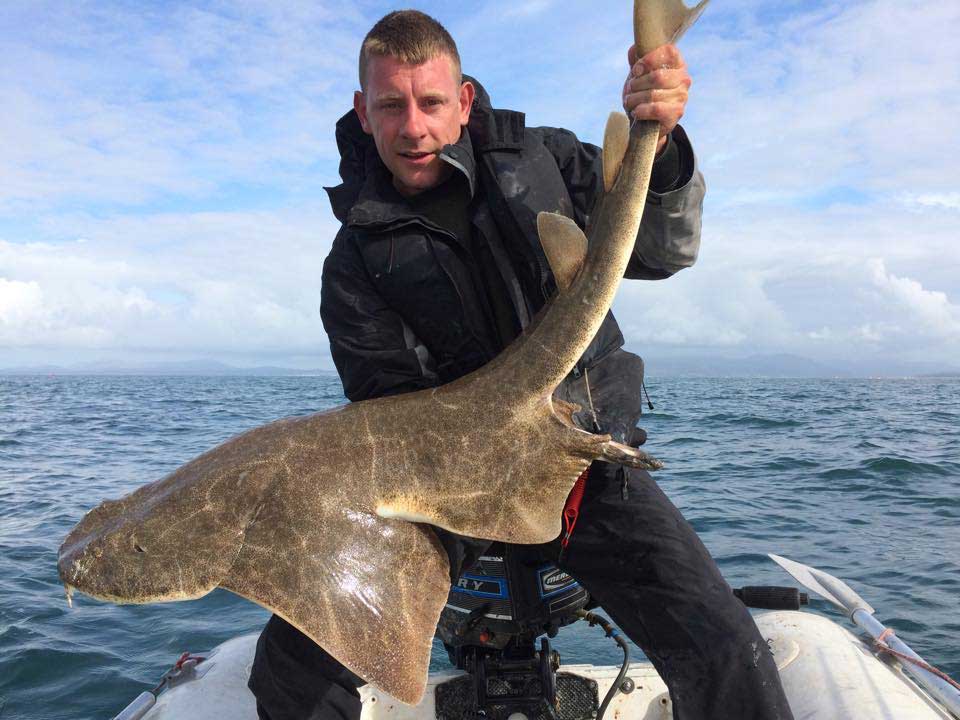 |
Angel
Shark
about
to be returned to the sea
Photographs
by Michael
Griffiths
A large two metre long (including the long tail) Angel Shark, Squatina squatina, was caught by Michael Griffiths on road and line off Shell Island, north Wales. This very rare and protected shark is thought to be extinct in the English Channel and still extremely rare in Cardigan Bay.
20
March 2015
A
small Angel Shark, Squatina
squatina,
was a rare capture off Douglas,
Isle of Man.
Angel
Shark
Photograph
by Grant Lopes
This
large stocky angel shark was formerly a common and important demersal predator
over large areas of its coastal and outer continental shelf sediment habitat
in the North-east Atlantic, Mediterranean and Black Seas. It now appears
to be absent from the English Channel where it was caught back in 1969.
This
protected
shark is classified as "Critically Endangered".
Red
List entry
OSPAR
Assessment
MarLIN
Records
Shark
Trust Factsheet
30
July 2010
The
now extremely rare Angel Shark (or
Monkfish), Squatina
squatina, was accidentally caught
off
Porthcawl (Wales)
in the Bristol Channel. It weighed 16.7 kg and its length was 123 cm including
the long tail. The shark was collected by the Natural
History Museum for research purposes.
In
2008,
the Angel Shark
received full legal protection from human activities in the waters off
England and Wales from the coast to a distance of 11 km (6.8 miles), under
the UK Wildlife and Countryside
Act. The United Kingdom and Belgium have pushed, unsuccessfully, for
this species to be listed on the Convention for the Protection of the Marine
Environment of the North-East Atlantic (OSPAR) Priority List of Threatened
and Endangered Species.
20
October 2012
An
albino
Nursehound,
Scyliorhinus
stellaris, was
caught by angler Tojo
from a boat out of Holyhead,
Anglesey.
The unusual white shark was returned to the sea.
RECOMMENDED SITE:
Capt.
Tom's Guide to New England Sharks, USA
Basking Shark
Family: Cetorhinidae
Basking
Shark News Item 1998, Cetorhinus maximus. .
Basking
Shark Reports, 1998,
1999.
Basking Sharks
(more)
The largest Basking Shark
recorded in British seas was washed up on Brighton beach, Sussex, in 1806.
The weight was estimated at 8 tonnes, if the record is to be believed.
AH.
9
July 1999
Proposal
to include the Basking Shark (Cetorhinus maximus) on Appendix II
of the Convention on International Trade in Endangered Species (CITES)
DETR
http://www.wildlife-countryside.detr.gov.uk/gwd/shark/Index.htm
January
1998:
A large shark of over 5
metres long (16 ft) long was seen in Sandsound Voe on the western coast
of the Shetland Isles attacking seals, which are attracted by the salmon
in the cages. The shark was estimated to weigh 500 kg. The species was
not identified. Species of shark in British seas that reach this size include
the Greenland Shark, Somniosus
microcephalus, which will attain lengths of over 6 metres and is
known to attack seals on occasions. This shark is a northern species which
is not often recorded off the coast of Scotland. Both Philip Vas and Len
Nevell have suggested it could be a Six-gilled
Shark, Hexanchus griseus.
Six-gilled
Shark Page 2
Tope
Galeorhinus galeus
June
1997.
A Tope with an estimated
weight in excess of 42 kg (93 lb) was caught by Margaret Tuckwell
whilst fishing off Selsey Bill, Sussex, at a mark known as the Mixon Hole,
which is popular with divers. This weight would have been a world record
if the shark had been landed alive and weighed, but this specimen was returned
to the sea, The current rod and line record of Galeorhinus galeus,
is 37.4 kg (82 lb 8 oz) for a Tope caught off Bradwell-on-Sea,
Essex, (southern North Sea) in 1991, with another large fish caught in
the same area in 1986. Tope are not very common in the English Channel
and most angled specimens are caught in the summer months. The sharks migrate
in from more southerly seas. The Tope caught at Selsey was 198 cm long
and 78 cm in girth.
The
weight has since be revised to an estimate of 35 kg.
On
24
October 1994 angler Fred Oakley at Santa Monica
California took a
98
lb
8 oz (44.67 kg) Tope, Galeorhinus galeus. Source is
IGFA World record
fishes.
- Tom
Capt.
Tom's shark webpage
22
September 1999
A
large Tope, Galeorhinus galeus,
weighing
between 38 and 40 kg (85 to 90
lb), was tagged and released off
the Isles of Mull, Scotland, not knowing that it was a new record weight
for the species.
This
weight may be overestimated. A figure of 25 kg (55 lb) seems about
right.
A Tope of 50 lb was caught off Minehead, Somerset, by Richard Hoddinott.
Tope are on display in the large tank at Brighton Sea Life Centre.
Shark Attack Book
Shark & Ray Conference Report 1996 (BMLSS Scotland)
Shark Conference Report 1998
Skate & Tope Tagging in Scotland
Six-gill Shark
Six-gilled
Shark Hexanchus
griseus
Smoothhound
Skate
Flapper Skate, Dipturus intermedia, (=Diptrus batis*)
* In 2009, research showed what was formerly listed as a single species, Dipturus batis, should be instead classified as two separate species, Dipturus flossada, and the Flapper Skate, Dipturus intermedia.
Eagle Ray
4 May
1999
A
2779 gram (2.779 kg.) female Eagle Ray,
Myliobatis
aquila, was caught by trawl in 15 metres of water at about 2000
hours on Schole bank, off Guernsey, Channel Islands, English Channel.
The bank is composed of broken shell and sand.
The
Eagle Ray was caught with blonde rays, brill and a few lesser spotted dogfish.
The
Eagle Ray had a wing span of 585 mm and a total length of 956 mm. The body
length (tip of snout to origin of tail) was 330 mm.
The
stomach and spiral valve contained two small squat lobsters, one hermit
crab, and pieces of scallop shell. The liver weighed 150 grams and
the ray weighed 2384 grams gutted.
Blonde Ray
August 1997.A Blonde Ray, Raja brachyura, with the edible wings weighing in excess of 19 kg was captured in a trawl off Prawle Point, Devon. This was a very large specimen. The weight of the whole ray was estimated at 23 kg.
22
September 1999
A Blonde Ray of 14 kg (30lb)
caught off East Ferry, Cork, Eire, by Norman
Dunlop.
17
July 2000
An
Electric
Ray,Torpedo nobiliana, was caught, whilst
fishing for Nephrops (Scampi), 8 miles north of Lossiemouth, Moray
Firth, NW Scotland, by the Banff registered vessel "Charisma". The ray
immediately made one of the crew aware of it by giving him an electric
shock. It has found a temporary home in the MacDuff
Public Aquarium but it is not on public display because of the danger
to the public in their open ray tank. It will be returned to sea. This
species is the commoner of the two species of Electric Ray found around
Britain (the other one is the Marbled Electric Ray, Torpedo marmorata)
and both are generally southern species and are much rarer further north.
This species is one that divers should be warned not to touch, if they
spot a ray swimming in mid-water. Most records from British seas are in
the summer and autumn.
A small Electric Ray, Torpedo nobiliana, was caught by fisherman John Gillam off Brighton, Sussex. These fish are occasionally caught off the Sussex coast each year. What was unusual about this fish was that it was captured alive and put on display at Brighton Sea Life Centre.
August 1998. An Electric Ray, Torpedo nobiliana, was caught with some difficulty, because the powerful electric shocks transmitted up the line, by angler Steve Alnutt off Shoreham Beach, Sussex. It weighed 8 kg (18 lb) and was returned alive.
OE Ray = reohha, ruhha. The commercial fisheries name is Roker, and this is an alternative common name for the the Thornback Ray, Raja clavata.
15
October 2010
Gary
Crane received a shock when he landed a 4.95
kg (10 lb 14 oz 11 dram) female Marbled
Electric Ray, Torpedo
marmorata,
on
Richard
Seager’s ‘Out of Blue‘,
while fishing about three miles to the east of Sark, Channel Islands.
The electric ray had a total length of 58.6 cm and a disc width of 41.5
cm. The electric ray took a whole Black
Bream,
Spondyliosoma cantharus,
presented as bait. This specimen represents the largest Marbled
Electric Ray caught by an angler in British
waters.
BMLSS Angling Records Links page
BMLSS Sharks & Ray News
June
2008
A
rare female Marbled Electric Ray, Torpedomarmorata,
was
captured in a trawl net by Worthing fisherman Brian
Davey about eight miles off Shoreham-by-Sea,
Sussex. The ray which was about 60 cm long and can deliver a 220 volt electric
shock. It was kept alive found a home at Brighton
Sea Life Centre.
This
is the rarer of the two electric rays recorded in British seas and is extremely
rare off Sussex. This fish can grow up to 60 cm in length. It is not known
to breed in British seas and fish are likely to have migrated up the English
Channel in summer.
Sussex
Rare Fishes
Sussex
Marine Life Reports 2008
BMLSS
News Reports Spring 2008
The Marbled Electric Ray, Torpedo marmorata, is increasingly common around Guernsey. Commercial fishermen are catching them almost every week. The fishermen who caught the Eagle Ray told me he caught an electric ray yesterday but he wasn't certain which species it was (T. nobiliana or T. marmorata). Torpedo marmorata has been seen in breeding aggregations to the south of the Island of Sark in the Autumn.
Torpedo
marmorata appears to be much more common than T. nobiliana around
the
Bailiwick of Guernsey. The inshore gill netters catch them during
the winter and
trawlers
seem to get them on the banks during the summer months.
18
October 2009
A
recreational angler caught a 26.76 kg (59 lb exactly) female
Stingray,
Dasyatis
pastinaca, in shallow water near Vermerette
off the west coast of the island of Herm,
Channel Islands, (about 400 metres from Herm harbour) from a boat. The
ray had a total length of 124 cm and a disc width of 76 cm.
The stomach of the fish contained about 20 well digested Sandeels and some small shrimps (it is a bottom feeder.) The liver weighed 4859 grams (10.7 lb). This ray would have broken the British record of the fish had been caught from the shore.
BMLSS
Angling Records Links page
I recently interviewed a shore angler who had caught a 22 kg (46.5 lb) female Stingray Dasyatis pastinaca on the N.E England coast. While it was not measured properly, the angler estimated its DW at 1 metre (3 ft) and snout to tail stump also 1 metre. He was very interested to find out an age for the animal - does anyone have any ideas? The Stingray was caught in July or August 1998 which seems to be months in which they are most likely to be caught, when the sea is at its warmest.
.
Public Aquaria Database
15
September 1999
A
Stingray of 35 lb was caught off Poole, Dorset by Mark
Butler.
November 2015
 |
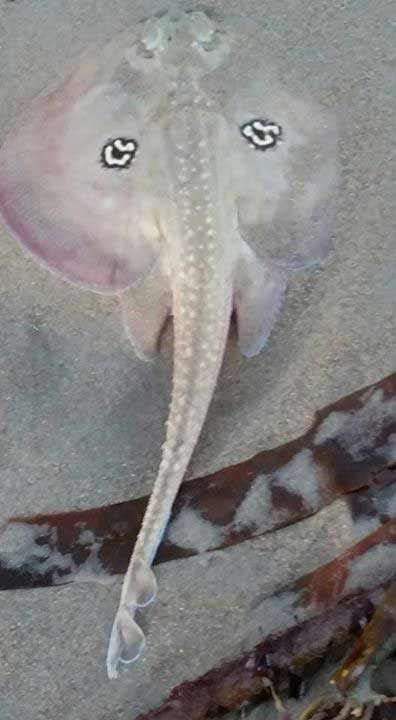 |
|
Photograph by Robyn Shilland |
Photograph by Larry Dunne |
31
July 2016
Anglers
caught a huge Thresher
Shark, Alopias vulpinus,
estimated from measurements to weigh 167 kg (368 lb), from a boat
off the coast of Cornwall.
A Thresher Shark, Alopias vulpinus, with a measured weight of 123 kg (271 lb) was caught on road and line by Dai Pig off Milford Haven and the measurements made it the largest recorded Thresher Shark angled off Wales. It was returned to the sea.
16
July 2015
A
Thresher
Shark, Alopias vulpinus,
with a measured weight of 115 kg (253 lb) (The shark measured 1.95
m from nose to tail fork and 3.35 m to the tip of the tail with a girth
of 1.065 m.) was caught on road of line out of Milford
Haven. The shark was returned to the sea. This was a new Welsh angling
record.
4
August 2012
In
living memory the Thresher Shark,
Alopias
vulpinus, was if not a regular sighting
off the Sussex coast,
it would be remarkable because of its exceptionally long caudal fin. Now,
a Thresher Shark
is a newsworthy event caught by a boat angler out of the notable shark
fishing centre of Looe,
south Cornwall. The
shark was landed and released.
Three
species of Thresher Shark
have been declared to be "vulnerable", according to the International
Union for Conservation of Nature and Natural Resources (IUCN) Red
List of threatened species.
Early
May 2008
A
Thresher
Shark,
Alopias
vulpinus, was
seen feeding at the surface off Portland,
Dorset, exceptionally early in the year.
A five metre long Thresher Shark, Alopias vulpinus, was landed at Newlyn Fish Market and was caught by skipper of The Imogen Roger Nowell whilst trawling for squid and John Dory off Land's End. It weighed weighed 510 kg (1,125 lb) and was the heaviest on record landed at Newlyn. Comparatively, the angling record fish weighed 146 kg. Commercial fishermen have landed Thresher Sharks up to 400 kg before.
18
May 2004
Three
professional anglers witnessed a Thresher
Shark,
Alopias, leap completely
out of the water, tail and all, four consecutive times to the west of Alderney,
Channel Islands, Great Britain at about
8:00
pm. One angler told me that he estimated the
body length of the shark at about 170 cm. The leaping activity occurred
about 100 metres away from their boat. The leaps were head first and perpendicular
out of the water. There were drifting while fishing for Bass,
Dicentrarchus
labrax, approximately one mile west of Garden Rock, which has a
large Gannet
colony covering the entire rock. Atlantic Mackerel
were also in the area.
10
November 1999
A juvenile
male Thresher Shark, Alopias vulpinus, was landed in Guernsey.
It was caught in gill nets about one mile south of Guernsey in about 20
metres of water. It measured 175 cm in total length, of which the long
forked caudal or tail fin is about this length.
More
Information
A male Thresher Shark, Alopia vulpinus, was landed at Plymouth. It was caught in a bottom set net off the south Devon coast. The length was given at 4.04 metres, but this may have included the long tail fin which is equal to the body length.
February
1999
A
230 cm male Thresher Shark, Alopius vulpinus, was taken
in midwater 16 miles SSW of Eddystone Rocks, south of Plymouth, Cornwall.
Thresher
Sharks are occasional summer migrants to the English Channel.
Sharp-nosed Seven-gilled Shark
July
1999
A Sharp-nosed
Seven-gilled Shark, Hepranchias perlo, was caught on a bottom-set
long-line to the west of the Isles of Scilly . This only the third record
of this shark in British and Irish* waters, the other records occurring
off Cornwall and southern Ireland. It was an immature female, which made
it a large specimen for its size, when compared to Pacific specimens. The
total length of the shark was 102 cm.
(*British
does not refer to UK territorial waters.)
Report
by Dr. Aaron C. Henderson
(who
dissected the specimen)
Martin
Ryan Marine Science Institute
National
University of Ireland, Galway, Republic of Ireland.
Shark reports not checked yet
British Sharks
Somnulosus
microcephalus
Etmopterus
spinax
Dalatias
licha
Echinorhinus
brucus
Hexanchus
griseus
Heptranehias
perlo
Chlamydoselachus
anguineus
Squalus
acanthias
Sphyrna
zygaena
Prionace
glauca
Mustelus
mustelus
Mustelus
asterias
Galeorhinus
galeus
Galeus
melastomus
Scyliorhinus
canicula
Scyliorhinus
stellaris
Squatina
squatina
Isurus
oxyrinchus
Alopius
vulpinus
Alopias
superciliosus
Lamna
nasus
Cetorhinus
maximus
Echinorhinus
brucus
All
Shark species (External)
Recommended Guide:
A Field Guide to the Sharks of British Coastal Waters
by Philip Vas
Field Studies Council Publications. Tel: 01743 850370.NEW BOOK
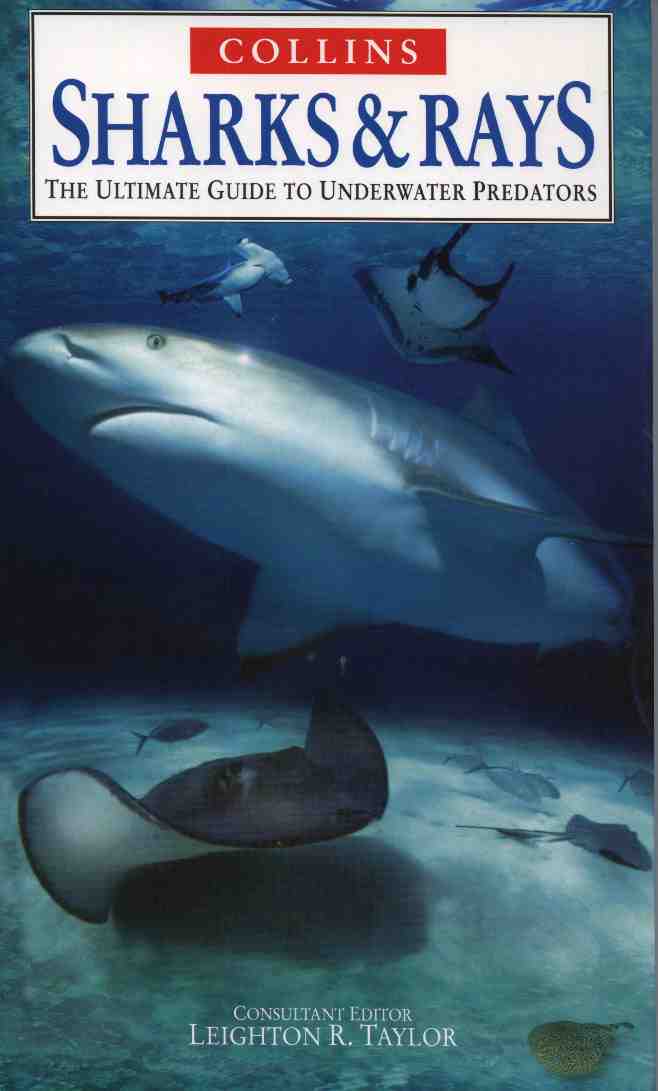
ISBN 0-00-220104-6
Basking Sharks (Isle of Man, UK)
Basking Shark Fact Sheet (USA)
Inference Search Engine (good for sharks)
Shark Discovery CD-ROM is available.
 EMail
for the BMLSS
EMail
for the BMLSS
Fish Page
International Marine News
Egg Capsules of Rays & Sharks
Fiona's
Shark Mania
Sharkman's
World
Shark
& Ray Species List (British)
| FIVE KINGDOMS
TAXONOMIC INDEX TO BRITISH MARINE WILDLIFE
Use these links if your are familiar with the scientific classifications of marine life |
|
|
|
|
|
News 2018 |
Membership Form |
|

